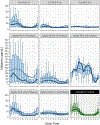Factors Disrupting Melatonin Secretion Rhythms During Critical Illness
- PMID: 32317599
- PMCID: PMC7242161
- DOI: 10.1097/CCM.0000000000004333
Factors Disrupting Melatonin Secretion Rhythms During Critical Illness
Abstract
Objectives: The circadian system modulates many important physiologic processes, synchronizing tissue-specific functions throughout the body. We sought to characterize acute alterations of circadian rhythms in critically ill patients and to evaluate associations between brain dysfunction, systemic multiple organ dysfunction, environmental stimuli that entrain the circadian rhythm (zeitgebers), rest-activity rhythms, and the central circadian rhythm-controlled melatonin secretion profile.
Design: Prospective study observing a cohort for 24-48 hours beginning within the first day of ICU admission.
Setting: Multiple specialized ICUs within an academic medical center.
Patients: Patients presenting from the community with acute onset of either intracerebral hemorrhage as a representative neurologic critical illness or sepsis as a representative systemic critical illness. Healthy control patients were studied in using modified constant routine in a clinical research unit.
Interventions: None.
Measurements and main results: Light, feeding, activity, medications, and other treatment exposures were evaluated along with validated measures of encephalopathy (Glasgow Coma Scale), multiple organ system function (Sequential Organ Failure Assessment score), and circadian rhythms (profiles of serum melatonin and its urinary metabolite 6-sulphatoxymelatonin). We studied 112 critically ill patients, including 53 with sepsis and 59 with intracerebral hemorrhage. Environmental exposures were abnormal, including light (dim), nutritional intake (reduced or absent and mistimed), and arousal stimuli (increased and mistimed). Melatonin amplitude and acrophase timing were generally preserved in awake patients but dampened and delayed with increasing encephalopathy severity. Melatonin hypersecretion was observed in patients exposed to catecholamine vasopressor infusions, but unaffected by sedatives. Change in vasopressor exposure was the only factor associated with changes in melatonin rhythms between days 1 and 2.
Conclusions: Encephalopathy severity and adrenergic agonist medication exposure were the primary factors contributing to abnormal melatonin rhythms. Improvements in encephalopathy and medical stabilization did not rapidly normalize rhythms. Urinary 6-sulphatoxymelatonin is not a reliable measure of the central circadian rhythm in critically ill patients.
Conflict of interest statement
Disclosures
All authors declare they have no conflicts of interest.
Figures



References
-
- Saper CB, Scammell TE, Lu J. Hypothalamic regulation of sleep and circadian rhythms. Nature 2005;437(7063):1257–1263. - PubMed
Publication types
MeSH terms
Substances
Grants and funding
LinkOut - more resources
Full Text Sources
Medical

